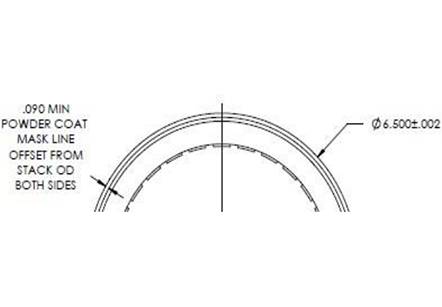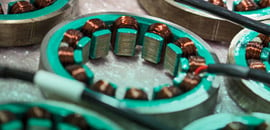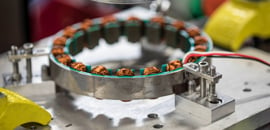Introduction to installing a Frameless Motor
This document details the installation and integration of Celera Motion frameless kit motors into our customers’ applications. It provides customers with the necessary information related to the mechanical design features of the mating parts to the kit motor. This includes descriptions of common methods of installing and retaining Celera Motion stators into housings and rotors onto shafts. General handling, safety and storing information is also provided.
Motor Handling
Safety Precautions
These devices contain high energy rare-earth magnets that produce strong magnetic fields. The following guidelines must be strictly adhered to in order to maintain the safety of all individuals involved with the handling of these devices.
Anyone having active implants, such as pacemakers, should keep a safe distance from the rotors of these motors. Magnetic flux density levels of 5 Gauss are typically described as the threshold for deactivating implanted medical devices. Unfortunately, the “safe” distance at which the flux density is less than 5 Gauss is dependent on many factors. It is dependent on the size of the rotor, the grade of magnetic material, the thickness of the magnet and even the presence of any steel in the surrounding area. The best method of ensuring a “safe” operating distance is to directly measure the flux density as a function of distance from the rotor and find the point where it is less than 5 Gauss. Lastly, it is impossible for us to know, or to make blanket statements about every available medical device. This guideline is intended to help designers assess risks associated with rotors containing high energy rare-earth magnets. A physician should be consulted if anyone having an active implant needs to handle rotors.
The rotors have strong magnetic attractive forces. Precautions should be taken to remove all other magnetic materials from within an area equal to 3 times the diameter of the rotor. Strong magnetic attractive forces can result in unintended and uncontrolled movement of magnetic items resulting in collisions between magnetic parts.
Strong magnetic fields produced by rotor magnets may affect or damage electronic devices and measuring equipment. Rotors should not be placed close to computer disks, computers, monitors or credit cards, etc.
As discussed above, the magnetic field strength is a function of the size of the rotor and other variables. Larger parts should be kept farther away from devices that are sensitive to static magnetic fields. Lists of electronic devices affected by magnets can be found via internet searches.
Unpacking
Frameless motor kits are generally shipped as two separate components in the same container. The stators and rotors are packaged separately. The typical contents of the shipping containers are:
- Stator Assembly
- Rotor Assembly
- Commutator (if available as an option and ordered)
- Copy of Final Test Report
- Copy of the Interface drawings
- Certificate of Compliance
The motors should be unpacked carefully to avoid damaging the motor components. Stators with integral hall devices are packaged in Electrostatic Discharge (ESD) protective bags. Follow standard ESD precautionary steps when removing these units from their packages. A good reference for ESD procedures is ANSI/ESD S20.20. Be careful not to damage or score any of the mounting surfaces. Avoid any significant impact on the windings or stress on the lead wires. Stator windings should not be placed on rough surfaces that might damage the insulation coating of the magnet wire.
Rotors have high strength magnets that can attract steel objects and other magnetic material from several inches away. This may cause uncontrolled collisions between the objects, resulting in probable damage. High energy, rare earth magnets are brittle and chip easily. Keep the rotors in their original packaging to reduce the possibility of magnet damage.
Storing
In general, containers and racks should be made from non-magnetic materials, or the motor components should be protected from direct contact with other magnetic materials. All motor parts should be protected from contact with small magnetic particles such as iron filings, chips, or dust. Small particles of magnetic materials can be attracted to the motor components and become lodged in the windings or air gap. Over time, these foreign particles can wear through the magnet wire coating due to vibration of the motor windings and cause a premature winding failure.
Corrosion protection of motor parts is an important consideration. It is best to store all motor kit parts in a controlled environment until they are ready to be used. Celera Motion neodymium rotor magnets are either epoxy or nickel plated for corrosion protection. Rotor back iron material may be a mild steel that has been nickel or zinc plated. A corrosion resistant magnetic stainless steel is also used in some rotor hubs. Common examples of magnetic stainless steels used are 17-4PH and 416. Overall, rotors have reasonable corrosion resistance in standard atmospheric storage environments. Stators, however, are only sprayed with a light varnish to inhibit corrosion. For extended storage, or storage in humid environments, these motor parts should be sealed in plastic bags containing a desiccant to help protect against corrosion. It is common for stators to develop a light surface oxidization. This should not be a concern; minor surface oxidation on the stator will not affect motor performance or lifespan.
Keep magnets away from magnetic steel parts at all times. Good practice is to keep a space free from magnetic materials around the part. The separation distance between the rotor and any magnetic material should be at least equal to the diameter of the part.
Housing Design and Stator Installation
The motor housing can be made of any material suitable for the customer’s environment and application. Celera Motion motors are self-contained magnetically so there is no concern or requirement to have a magnetically soft outer housing on the motor. Most motor systems use aluminum housings/frames.
General Housing Design Considerations
Celera Motion stators are designed with a region of bare steel exposed on both sides, (see Figures 1a and 1b). On our stator interface drawings, this is the region between the stator outer diameter, (OD), and the “powder coat mask line offset from stack OD”. This is intended to be a banking surface made to rest on a mating banking ledge within the housing. The width of the banking ledge on the housing should be designed to be slightly less than the width of the offset. In the example shown in the figures below, the bare steel region is .090” and the recommended width of the mating banking ledge would be .080”.

Figure 1a

Figure 1b
For the remainder of the housing design, good practice is to design any metal surfaces to be 2-3 mm away from the motor windings in all directions for electrical insulation purposes. The windings should not be in direct contact with any of the metal housing surfaces.
If grounding is required, a ground stud can be placed on the housing. While this is not exactly at the same voltage potential as the stator stack, it does represent a typical grounding scheme observed in most motors with two or three part housings. A ground stud is typically only required when the motor is going to operate with an off-line driver (with no isolation between the mains and the amplifier) or for electrical safety requirements.
In all applications using Celera Motion stators, extra axial room is required where the leads of the motor exit. This is typically 10-15 degrees of arc on one side of the stator. A small cavity with an associated hole to bring the leads out is all that is necessary.
Stator Retention within the Housing
There are five basic approaches used within the industry to secure stators into housings:
- Bolt in – the stator is bolted or screwed in place
- Press Fit – there is an interference fit by design and the stator is pressed into the housing.
- Heat shrink fit – the housing is heated to achieve a clearance fit. Then the stator is inserted.
- Adhesive Bond – An adhesive is used to bond the stator to the housing
- Axial clamp – Either a full 360 degree ring or a few “servo clamps” apply axial pressure to the stator stack to hold it in place.
Celera Motion does not offer a bolt-in option or recommend a press fit installation. When designing the stator to housing interface, the expected torque loads and joint strengths of the different retention options should be taken into consideration.
Bolt –In Stator Retention
High performance brushless motor stators are not typically retained via bolts running through holes in the lamination stack. Eddy currents may develop in the bolts, resulting in excess heating, torque drag, and loss of efficiency. Eddy current losses can be eliminated by “open” bolt holes or “notches” at the outer diameter of the lamination. Celera Motion motors are typically designed so that the lamination sections operate at maximum flux density levels. As a result, notches are only created by adding iron to the outer diameter of the motor in the space between the desired locations of the notches. Because this adds size and weight to the motor; Celera Motion motor kits do not offer this means of retention.
Press-Fit Stator Retention
Designing an interference fit between the stator and the housing, and installing the stator by pressing it into the housing is not recommended for Celera Motion kit motors. If the motor is to be operated over a wide environmental/operating temperature range, use of an interference fit often limits the choice of housing materials to those with coefficients of thermal expansion (CTE) that match the lamination material CTE. Another issue regarding the press method/design are that burrs can be created. These burrs have the potential to become slivers of metal that can lodge into windings and cause electrical failures. In addition, the lamination stack may “crack” or “split” if the pressing direction isn’t well controlled and the stack is not inserted perpendicular to the housing bore.
Heat Shrink Fit Stator Retention
Similar to Press-Fit Stator Retention, this method is also based on designing an interference fit between the stator and the housing, and suffers the same drawbacks related to CTE matching and potential limitations of material selections. Celera Motion does not recommend this method as the sole means of retention. We do recommend a light interference fit combined with an adhesive bond as described in the next section.
Adhesive Bonded Stator Retention
Adhesive bonding is one of the most common methods of stator retention and is recommended by Celera Motion in many applications. Adhesive bonding allows for the use of almost any material for the housing. Celera Motion recommends either 3M DP420 epoxy adhesive for moderate operating temperatures where the housing temperature is expected to be around 100°C, or Hysol E40HT for higher expected housing temperatures. If one of these epoxies adhesives is used, the housing should be designed with a .007”-.012” adhesive groove covering 50% to 75% of the axial length of the stator lamination stack. The adhesive groove can be centered axially on the stack, (see Figure 2), or located to one side, (see Figure 3). If a different type of adhesive is used, the adhesive manufacturer’s data sheets should be consulted for the recommended bond line design thickness. In both figures below, the stator shown is a slotless motor but the same mounting principles apply. The stator and rotor are shown in a two-piece housing in Figure 2, and a three-piece housing in Figure 3. The housings with bearings and wave washers are shown for general illustrative purposes. There can be many different variations of housing designs. A shaft, not depicted in the illustrations, would be designed by the customer.
The preferred installation process, performed with either of the two recommended epoxies, consists of heating the housing to 100°C or higher, quickly applying the adhesive to the adhesive groove in the hot housing, and immediately inserting the stator. The assembly is then cured at the epoxy cure temperature. The advantage of this method is that the housing bore can be designed to be a line-to-line or light/transitional interference fit with the stator depending on the housing material selection and material CTE. The adhesive cures in the expanded state and is under compression at all other temperatures.

Figure 2 – Two Piece Housing with Adhesive Groove Centered Axially on the Stack

Figure 3 – Three Piece Housing with Adhesive Groove Located on One Side of the Stack
If the housing cannot be heated prior to the stator installation, then the housing bore should be designed to be at least .001”-.002” larger than stator OD under worst case tolerance conditions. The factory can be consulted for selection of an appropriate adhesive if the housing material selection and environment/operating temperatures are atypical. However, 3M DP420 and Hysol E40HT are both good general purpose, toughened structural adhesives that can be used in most applications.
Axial Clamping Stator Retention
An axial clamping mechanism is also commonly used for stator retention. Celera Motion frameless motor stators have a bare steel banking surface on both sides of the stator, (see Figure 4). The stator is installed into the housing and seated onto the housing banking surface. A clamping ring should be designed that engages the top exposed banking surfaces and applies axial pressure by being bolted into the housing. The minimum clearance between the housing end face and the clamping ring should be designed to accommodate the +/- .014” stack length tolerance typical for most Celera Motion stators.
Axial clamping can also be implemented via “servo clamps”. These can be either short “L” shaped clamps or straight bars that are designed and function in the same manner as the full clamping ring. See Figures 5 and 6 below.
Rotor Selection and Installation
An example of a frameless motor kit rotor is shown below in Figure 7. In this example, the rotor magnet is a lower energy, one piece, compression bonded, ring magnet mounted concentrically to a back iron ring. Celera Motion offers kits with and without the back iron ring for this type of magnet. If the customer’s end system uses a rotor hub made from a soft magnetic material, the Celera Motion back iron ring is not required. Alternatively, Celera Motion can mount magnets directly onto custom hubs and provide complete custom assemblies; thereby reducing the number of part and assembly operations.
If the system uses a non-magnetic hub, ordering a rotor with the integral back iron ring will provide the best torque performance. However, if there is no room, or the customer opts not to use the back iron ring and consequently there is no magnetic return path for the magnets, then motor torque performance parameters may be reduced by 10%-20%. Please consult the factory for the actual reduction in torque constant in this set of circumstances.
Magnetic attractive forces between the rotor and stator can be very high (several hundred pounds for large motors). It is very important that caution and care be taken when assembling the two parts. FREE-HAND INSTALLATION OF LARGER ROTORS IS NOT RECOMMENDED, AND CAN RESULT IN INJURY TO THE INSTALLER!
To protect both the magnets and stator teeth from damage parts during installation of the rotor into the stator, a non-magnetic sleeve .010”-.020” thick can be used to wrap around the rotor during the installation process. Plastic shim stock or Mylar work well as sleeves. Once the rotor is installed in the stator, and the assembly is complete, the sleeve can be removed.
The same five basic approaches used to secure stators into housings are also applicable to rotors. A sixth approach is to secure the rotor with a key and keyway. Expected torque loads and joint strengths of the different retention options should be considered when designing and choosing the rotor to shaft interface method.
- Bolt in – the rotor is bolted to a mating hub
- Press Fit – there is an interference fit by design and the rotor is pressed over the shaft.
- Heat shrink fit – the rotor is heated and the shaft cooled to achieve a clearance fit and then the rotor is installed onto the shaft.
- Adhesive Bond – An adhesive is used to bond the rotor to the shaft
- Axial clamp – A clamping ring is bolted in place to apply axial pressure to the rotor hub to hold it in place.
- Keyed rotor and shaft.
Bolt–In Rotor Retention
Celera Motion standard hubs are thin rings that do not have additional mounting features. However, custom hubs with customer specified mounting features and bolt-hole patterns are an option that can be discussed with the factory.
Press-Fit Rotor Retention
Designing an interference fit between the rotor hub and the shaft and installing the rotor by pressing it onto shaft is an option. However, the amount of interference must be designed to ensure that the magnet bonding integrity is not compromised. We do NOT recommend a press fit installation if the rotor uses a one piece ring magnet because the expanded state of the hub can cause the magnet to crack. This risk is eliminated if the rotor consists of individual magnet segments bonded onto a hub. In this case, a press fit is generally acceptable. Care should be taken during the press operation to only press upon the steel portion of the hub – not on the magnets. Sometimes, for a press fit, the shaft is designed with a relief step so that the interference fit is only over a partial length of the rotor.
Heat Shrink Fit Rotor Retention
Similar to press fit, this method is also based on designing an interference fit between the rotor and the shaft, and suffers the same concerns regarding one piece ring magnets. Additionally, if the hub is heated to over 100°C, there is a risk of permanent demagnetization of the rotor magnets. This method is generally not recommended without consulting the factory.
Adhesive Bonded Rotor Retention
Adhesive bonding is one of the most common methods of rotor retention, and is normally recommended by Celera Motion. It allows the use of almost any material for the mating hub. Differences in CTE’s and expected operating temperatures should always be taken into consideration. The mating shaft should be designed with an adhesive groove covering 50% to 75% of the axial length of the rotor hub. The depth will be dependent on the type of adhesive used, and the adhesive manufacturer’s data sheets should be consulted. Celera Motion recommends either 3M DP420 or Hysol/Loctite E40HT. For these epoxies, and similar epoxy based structural adhesives, we recommend the depth of the adhesive groove on the rotor mating part to be .007” to .012”. These epoxies have been used to assemble thousands of Celera Motion magnets and hubs and have withstood the typical temperature ranges that occur during motor operation.
Axial Clamping Rotor Retention
An axial clamping mechanism is also commonly used for rotor retention. It is critical, however, not to clamp on the magnet material because it is very brittle. For small motors, axial clamping can be achieved by a step banking surface on one end of the rotor, and a washer with jam nut threaded onto the shaft on the other end of the rotor. For larger hubs, an endplate is needed as shown below in Figure 8.
Key-way Rotor Retention
Celera Motion standard hubs do not have keyways. However, customers can contact the factory and order special custom hub configurations if desired. We do not normally recommend keys as a rotor retention solution for several reasons: it is typically an expensive feature to add, it requires a thicker hub cross-section, it still requires some means of axial clamping, and for smaller motors, it is overdesigned with respect to typical torque loads.
Conclusion
By following the previously defined guidelines, Celera Motion expects the customer to achieve the most beneficial results when handling, integrating, and installing frameless motors. For any questions regarding the installation process, or design features for mating parts, contact a Celera Motion representative.






